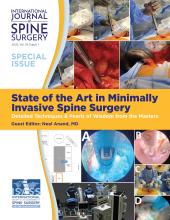ABSTRACT
Background Informed patient selection and counseling is key in improving surgical outcomes. Understanding the impact that certain baseline variables can have on postoperative outcomes is essential in optimizing treatment for certain symptoms, such as radiculopathy from cervical spine pathologies. The aim was to identify baseline characteristics that were related to improved or worsened postoperative outcomes for patients undergoing surgery for cervical spine radiculopathic pain.
Methods Retrospective review of prospectively collected data. Patient Sample: Surgical cervical spine patients with a diagnosis classification of “degenerative.” Diagnoses included in the “degenerative” category were those that caused radiculopathy: cervical disc herniation, cervical stenosis, and cervical spondylosis without myelopathy. Baseline variables considered as predictors were: (1) age, (2) body mass index (BMI), (3) gender, (4) history of cervical spine surgery, (5) baseline Neck Disability Index (NDI) score, (6) baseline SF-36 Physical Component Summary (PCS) scores, (7) baseline SF-36 Mental Component Summary (MCS) scores, (8) Visual Analogue Scale (VAS) Arm score, and (9) VAS Neck. Outcome Measures: Improvement in NDI (≥50%), VAS Arm/Neck (≥50%), SF-36 PCS/MCS (≥10%) scores at 2-years postoperative. An arm-to-neck ratio (ANR) was also generated from baseline VAS scores. Univariate and multivariate analyses evaluated predictors for 2-year postoperative outcome improvements, controlling for surgical complications and technique.
Results Three hundred ninety-eight patients were included. Patients with ANR ≤ 1 (n = 214) were less likely to reach improvements in 2-year NDI (30.0% vs 39.2%, P = .050) and SF-36 PCS (42.4% vs 53.5%, P = .025). Multivariate analysis for neck disability revealed higher baseline SF-36 PCS (odds ratio [OR] 1.053) and MCS (OR 1.028) were associated with over 50% improvements. Higher baseline NDI were reduced odds of postoperative neck pain improvement (OR 0.958). Arm pain greater than neck pain at baseline was associated with both increased odds of postoperative arm pain improvement (OR 1.707) and SF36 PCS improvement (OR 1.495).
Conclusions This study identified specific symptom locations and health-related quality of life (HRQL) scores, which were associated with postoperative pain and disability improvement. In particular, baseline arm pain greater than neck pain was determined to have the greatest impact on whether patients met at least 50% improvement in their upper body pain score. These findings are important for clinicians to optimize patient outcomes through effective preoperative counseling.
Footnotes
Disclosures and COI: Dr. Passias reports consultancy for Medicrea and SpineWave, speaking/teaching arrangements from Zimmer-Biomet, and grant from CSRS, all outside the submitted work. All other authors have no conflicts of interest to report. Institutional Review Board (IRB) approval was obtained from each contributing center prior to study initiation.
- ©International Society for the Advancement of Spine Surgery







